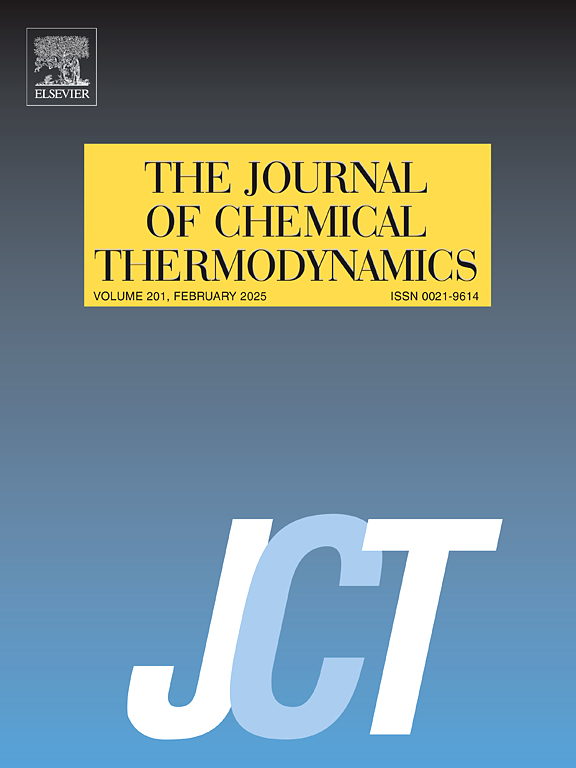5-氨基-1,3,4-噻二唑-2-硫醇在13种有机单溶剂中的平衡溶解度、模型分析、溶剂效应和热力学性质
IF 2.2
3区 工程技术
Q3 CHEMISTRY, PHYSICAL
引用次数: 0
摘要
用重量法测定了5-氨基-1,3,4-噻二唑-2-硫醇(AMTD)在甲醇、乙醇、正丙醇、正丙醇、正丁醇、正丁醇、正丁醇、正丁醇、正丁醇、正丁醇、乙酸甲酯、乙酸乙酯、乙酸丙酯、乙酸丁酯、丙酮和环己酮等13种单溶剂中的溶解度。AMTD在不同溶剂中的溶解度随温度的升高而增大。AMTD在醇类溶剂中的溶解度顺序为:甲醇>;乙醇比;s-butanol祝辞i-propanol祝辞正丙醇比;正丁醇的在i-butanol。在酯类试剂中,溶解度顺序为:醋酸甲酯>;乙酸乙酯>;醋酸丙酯>;乙酸丁酯。在酮类溶剂中,AMTD更容易溶解。溶解度数据采用改进的Apelblat模型、Yaws模型和van't Hoff模型进行拟合。RAD < 0.86 × 10−2,RMSD < 9.84 × 10−3。采用Hansen溶解度参数和KAT-LSER模型研究了溶质-溶剂相互作用和溶剂效应。采用Hirshfeld表面分析和分子静电势表面分析研究溶质与溶剂的分子间相互作用。根据范霍夫模型计算了AMTD溶解过程的热力学数据。本文章由计算机程序翻译,如有差异,请以英文原文为准。

Equilibrium solubilities, model analysis, solvent effect, and thermodynamic properties of 5-amino-1,3,4-thiadiazole-2-thiol in thirteen organic mono-solvents
The solubility of 5-Amino-1,3,4-thiadiazole-2-thiol (AMTD) in 13 kinds of mono- solvents (including methanol, ethanol, n-propanol, i-propanol, n-butanol, i-butanol, s-butanol, methyl acetate, ethyl acetate, propyl acetate, butyl acetate, acetone and cyclohexanone) were measured by a gravimetric method at different temperatures. The solubility of AMTD in different solvents increases with the increase of temperature. AMTD solubility sequence in the alcohol solvent is: methanol > ethanol > s-butanol > i-propanol > n-propanol > n-butanol > i-butanol. In the ester reagent, the solubility order is: methyl acetate > ethyl acetate > propyl acetate > butyl acetate. In keto solvents, AMTD is more soluble. The solubility data were fitted with the modified Apelblat model, Yaws model, and van't Hoff model. RAD and RMSD are all less than 0.86 × 10−2 and 9.84 × 10−3, respectively. Hansen solubility parameters and KAT-LSER model were used to study the solute-solvent interaction and solvent effect. Hirshfeld surface analysis and molecular electrostatic potential surface analysis were selected to investigate the intermolecular interactions of solute and solvent. The thermodynamic data of AMTD dissolution process were calculated according to the van't Hoff model.
求助全文
通过发布文献求助,成功后即可免费获取论文全文。
去求助
来源期刊

Journal of Chemical Thermodynamics
工程技术-热力学
CiteScore
5.60
自引率
15.40%
发文量
199
审稿时长
79 days
期刊介绍:
The Journal of Chemical Thermodynamics exists primarily for dissemination of significant new knowledge in experimental equilibrium thermodynamics and transport properties of chemical systems. The defining attributes of The Journal are the quality and relevance of the papers published.
The Journal publishes work relating to gases, liquids, solids, polymers, mixtures, solutions and interfaces. Studies on systems with variability, such as biological or bio-based materials, gas hydrates, among others, will also be considered provided these are well characterized and reproducible where possible. Experimental methods should be described in sufficient detail to allow critical assessment of the accuracy claimed.
Authors are encouraged to provide physical or chemical interpretations of the results. Articles can contain modelling sections providing representations of data or molecular insights into the properties or transformations studied. Theoretical papers on chemical thermodynamics using molecular theory or modelling are also considered.
The Journal welcomes review articles in the field of chemical thermodynamics but prospective authors should first consult one of the Editors concerning the suitability of the proposed review.
Contributions of a routine nature or reporting on uncharacterised materials are not accepted.
 求助内容:
求助内容: 应助结果提醒方式:
应助结果提醒方式:


